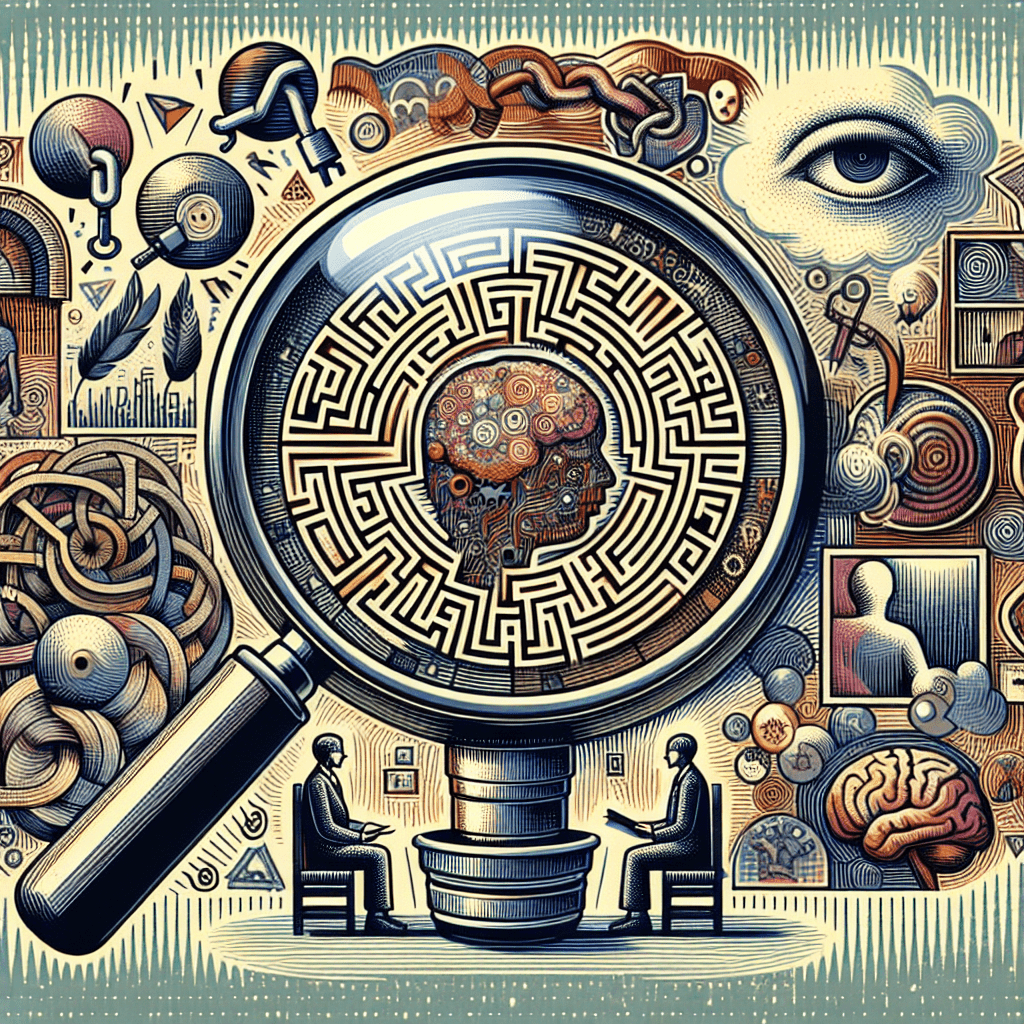Imagine you’re seeking therapy, but you’re not sure which approach is best for you. In a sea of options, one question rings louder than the rest: how does psychoanalysis differ from other therapy services? While many therapeutic approaches focus on the conscious mind, psychoanalysis delves into the depths of the unconscious, offering a unique and profound exploration of one’s inner self. By uncovering hidden motivations and unresolved conflicts, psychoanalysis aims to bring lasting and transformative change. So, if you’re ready to embark on a journey of self-discovery like no other, let’s explore how psychoanalysis sets itself apart from other therapy services.

Overview
Definition of psychoanalysis
Psychoanalysis is a form of therapy that delves beyond surface-level symptoms to explore the unconscious mind. It is a comprehensive and intensive therapy approach that aims to bring awareness and insight into one’s thoughts, emotions, and behaviors. Through the process of psychoanalysis, individuals can gain a deeper understanding of their inner conflicts, traumas, and repressed memories, ultimately leading to personal growth and healing.
Types of therapy services
While psychoanalysis is a prominent therapeutic approach, there are various other therapy services available. These include cognitive-behavioral therapy (CBT), humanistic therapy, psychodynamic therapy, and solution-focused therapy, among others. Each of these therapy services has its own unique techniques and focuses, catering to different individuals and their specific needs.
Purpose of the article
The purpose of this article is to provide a comprehensive understanding of psychoanalysis and differentiate it from other therapy services. By examining its philosophy, approach and techniques, duration and frequency, therapist-patient relationship, focus and goals, role of childhood and early experiences, scope of issues addressed, evidence base and scientific validity, as well as cost and accessibility, readers will gain a clear insight into the distinctive nature of psychoanalysis.
Philosophy and Background
Founding principles of psychoanalysis
Psychoanalysis, developed by Sigmund Freud, is founded on the principles of the unconscious mind and its influence on human behavior. It posits that individuals are not always aware of the underlying motives and desires that shape their thoughts and actions. Psychoanalysis aims to bring these unconscious conflicts to the forefront of awareness, allowing individuals to gain insight and resolve internal struggles.
Influence of Sigmund Freud
Sigmund Freud’s groundbreaking work laid the foundation for psychoanalysis. His theories on the id, ego, and superego, as well as the psychosexual stages of development, revolutionized the field of psychology. Freud’s emphasis on the importance of childhood experiences, dreams, and the interpretation of unconscious symbolism continue to be influential in psychoanalytic practice.
Development and evolution of other therapy services
Throughout the years, other therapy services have emerged that draw inspiration from psychoanalysis while incorporating different theoretical frameworks. Psychodynamic therapy, for example, builds on Freudian concepts but focuses more on interpersonal relationships and the impact of early experiences. Cognitive-behavioral therapy emphasizes the role of thoughts and behaviors in influencing emotions. These therapeutic approaches have evolved to cater to diverse client needs and address a wide array of mental health concerns.
Approach and Techniques
Exploring the unconscious mind
The exploration of the unconscious mind is central to psychoanalysis. Therapists guide individuals in uncovering hidden thoughts, feelings, and memories that lie beneath the surface. By bringing these unconscious processes into conscious awareness, individuals gain a deeper understanding of their motivations, conflicts, and unresolved issues.
Role of free association
Free association is a fundamental technique in psychoanalysis. Individuals are encouraged to speak freely without censorship, allowing their thoughts to flow naturally. Through this process, the therapist gains insight into the client’s unconscious mind, observing patterns, symbols, and themes that may offer valuable clues to unresolved conflicts.
Interpretation of dreams
Dream analysis plays a pivotal role in psychoanalysis. Dreams are seen as a gateway to the unconscious, where repressed desires and unconscious conflicts are expressed symbolically. Psychoanalysts work with clients to interpret the meaning behind these dreams, uncovering unconscious thoughts and emotions that may be impacting their daily lives.
Use of transference
Transference, a powerful therapeutic tool, occurs when a client projects their feelings and attitudes onto the therapist. In psychoanalysis, transference is explored and worked through to gain insight into the client’s past relationships and unresolved conflicts. By recognizing and understanding these transference dynamics, clients can gain a deeper understanding of their own patterns of behavior.
Psychoanalytic techniques in other therapies
While psychoanalysis has its unique set of techniques, elements of psychoanalytic theory and practice are integrated into various other therapy services. For example, psychodynamic therapy incorporates psychoanalytic principles such as exploring unconscious dynamics and the significance of early experiences. These techniques can also be found in some aspects of cognitive-behavioral therapy, particularly when addressing deep-seated emotional issues.

Duration and Frequency
Long-term commitment to psychoanalysis
Psychoanalysis typically requires a long-term commitment, often extending over several years. Due to the depth of exploration and the intricate nature of the unconscious mind, meaningful progress can take time. Regular sessions are necessary to establish a therapeutic relationship, explore unconscious conflicts, and work towards lasting change.
Frequency of sessions
Psychoanalysis sessions are typically held several times a week. This high frequency allows for consistent exploration of unconscious processes and the establishment of a strong therapeutic alliance. Regular sessions also provide ample opportunities for transference and the interpretation of dreams, ultimately facilitating a more comprehensive understanding of one’s inner world.
Shorter duration of other therapy services
In contrast to psychoanalysis, many other therapy services offer shorter durations of treatment. Cognitive-behavioral therapy, for example, may be structured in a time-limited manner, focusing on specific goals and providing practical strategies to address immediate concerns. These shorter durations cater to individuals seeking more focused and problem-oriented interventions.
Flexibility in session frequency
Unlike the rigid schedule of psychoanalysis, other therapy services often provide flexibility in session frequency. Depending on the individual’s needs, sessions can be scheduled weekly, bi-weekly, or even monthly. This flexibility allows for greater customization and accommodates individuals with varying time constraints and financial resources.
Therapist-Patient Relationship
Emphasis on the therapeutic alliance
Establishing a strong therapeutic alliance is crucial in psychoanalysis. The therapist and the client work collaboratively to create a secure and non-judgmental space conducive to exploring profound emotional experiences. The therapeutic alliance provides a foundation for trust, openness, and honest self-reflection necessary for personal growth and healing.
Use of blank screen approach
In psychoanalysis, therapists often adopt a “blank screen” approach, presenting themselves as neutral and non-directive. This approach allows individuals to freely express their thoughts and emotions without feeling judged or influenced by the therapist’s values or opinions. The therapist’s role is primarily to listen, observe, and facilitate the exploration of unconscious processes.
Non-directive vs. directive nature of therapy
Psychoanalysis is known for its non-directive nature, with therapists taking a backseat in guiding the therapeutic process. The focus is on self-discovery and self-reflection, allowing individuals to gain insights into their own thoughts and behaviors. In contrast, other therapy services, such as cognitive-behavioral therapy, may adopt a more directive approach, providing specific strategies and techniques to address identified problems.
Collaboration and active participation
While psychoanalysis places a strong emphasis on exploring the unconscious mind, it also involves collaborative work between the therapist and the client. Active participation is encouraged, with clients sharing their thoughts, feelings, and dreams, as well as engaging in discussions and interpretations. This collaborative process fosters a deeper understanding of one’s inner world and promotes active engagement in the therapeutic journey.
Focus and Goals
Exploration of unconscious conflicts
Psychoanalysis focuses on uncovering and resolving unconscious conflicts. By examining unconscious thoughts, emotions, and desires, individuals can gain insight into the root causes of their psychological distress. Through this exploration, individuals can develop healthier coping mechanisms, establish more fulfilling relationships, and achieve a greater sense of self-understanding.
Understanding the root causes of symptoms
Another primary goal of psychoanalysis is to understand the root causes of symptoms. Rather than merely treating the surface-level manifestations of distress, psychoanalysis seeks to identify the underlying psychological and emotional factors contributing to these symptoms. By addressing these root causes, lasting change can be achieved.
Insight-oriented approach
Psychoanalysis is driven by an insight-oriented approach. It aims to provide individuals with profound insights into their unconscious mind and internal conflicts. The belief is that through gaining awareness, individuals can make conscious choices and effect meaningful change in their lives.
Symptom reduction and problem-solving in other therapies
In contrast to the deep exploration of psychoanalysis, other therapy services often adopt a more symptom-focused approach. Cognitive-behavioral therapy, for instance, aims to identify and modify maladaptive thoughts and behaviors that contribute to psychological distress. By providing practical strategies and problem-solving techniques, these therapies aim to alleviate symptoms and improve overall functioning.
Role of Childhood and Early Experiences
Significance of childhood experiences in psychoanalysis
Psychoanalysis places great importance on childhood experiences and their impact on adult behaviors and emotions. It suggests that unresolved conflicts and traumas from childhood can continue to influence individuals into adulthood. By revisiting and understanding these early experiences within the therapeutic setting, individuals can gain insight into patterns of behavior and develop strategies for growth and healing.
Uncovering repressed memories
Psychoanalysis seeks to uncover repressed memories that may have been forgotten or buried deep in the unconscious mind. These repressed memories often hold emotional significance and can be sources of unresolved conflict. By bringing these memories into conscious awareness, individuals can process and integrate them, ultimately promoting psychological well-being.
Importance of past experiences in other therapies
While other therapy services may not delve as deeply into childhood experiences as psychoanalysis, they still recognize the importance of past experiences in shaping current behaviors and emotions. Psychodynamic therapy, for example, acknowledges the influence of early relationships on present-day functioning. By exploring these early experiences, individuals can gain insight into their thought patterns and interpersonal dynamics.
Scope of Issues Addressed
Broad range of psychological issues
Psychoanalysis is effective in addressing a broad range of psychological issues. It is particularly beneficial for individuals struggling with deep-seated emotional problems, personality disorders, and unresolved traumas. By providing a comprehensive and in-depth exploration of the unconscious mind, psychoanalysis offers a pathway to understanding and overcoming complex psychological challenges.
Deep-seated and complex emotional problems
Psychoanalysis stands out when it comes to addressing deep-seated and complex emotional problems. Its focus on exploring unconscious thoughts and unresolved conflicts allows for a thorough examination of the underlying causes of emotional distress. By working through these issues within the therapeutic relationship, individuals can experience significant emotional growth and healing.
Specific and time-limited issues in other therapies
In contrast, other therapy services often excel in addressing specific and time-limited issues. For example, solution-focused therapy concentrates on practical problem-solving techniques and short-term goal attainment. Additionally, cognitive-behavioral therapy is highly effective in treating specific anxiety disorders or phobias through targeted strategies and behavioral interventions.
Evidence Base and Scientific Validity
Critiques and controversies surrounding psychoanalysis
Psychoanalysis has been subject to various critiques and controversies over the years. Some criticize the lack of empirical evidence supporting its effectiveness, while others question the extensive duration and frequency of sessions. Additionally, the interpretation of dreams and the reliance on the therapist’s subjective interpretations have also been points of contention within the scientific community.
Empirical support and research in other therapy services
Many other therapy services have a solid empirical base supporting their effectiveness. Cognitive-behavioral therapy, for instance, has extensive research demonstrating its efficacy in treating various mental health conditions. Psychodynamic therapy, with its focus on understanding unconscious dynamics, also has empirical support, although to a lesser extent than cognitive-behavioral therapy.
Integration of different therapeutic approaches
In recent years, there has been an increasing trend towards integrating different therapeutic approaches. This integrative approach acknowledges that each therapy service has its own unique strengths and limitations. By combining various techniques and theories, therapists are able to provide more tailored and effective treatment plans tailored to the individual’s specific needs and goals.
Cost and Accessibility
Expensive nature of psychoanalysis
One significant consideration when opting for psychoanalysis is its cost. Due to its long-term and intensive nature, psychoanalysis can be more expensive compared to other therapy services. The frequent sessions over an extended period of time, often spanning years, contribute to the overall cost, making it a significant financial commitment for individuals seeking this form of therapy.
Long-term financial commitment
As mentioned, psychoanalysis requires a long-term financial commitment. The extended duration of treatment means that individuals need to plan and budget accordingly to ensure they can sustain the therapy. Depending on individual financial resources and insurance coverage, this commitment can be a limiting factor for some individuals seeking psychoanalytic treatment.
Affordability and availability of other therapy services
In contrast to psychoanalysis, other therapy services often offer more affordable options. These services may have shorter durations and less frequent sessions, resulting in lower overall costs. Additionally, the availability of other therapy services, such as cognitive-behavioral therapy or group therapy, is often more abundant, making them accessible to a wider range of individuals seeking treatment.
Insurance coverage
Insurance coverage for psychoanalysis varies, with some insurance plans offering partial or full coverage, while others may not include it in their mental health services. It is important for individuals considering psychoanalysis to check their insurance coverage and inquire about any potential limitations or reimbursement options. Other therapy services, such as cognitive-behavioral therapy, tend to have more standardized insurance coverage, making them more accessible to individuals with varying financial means.
In conclusion, psychoanalysis differs from other therapy services in several key ways. Its focus on exploring the unconscious mind, extensive duration and frequency of sessions, emphasis on the therapeutic alliance and insight-oriented approach, as well as the significance of childhood experiences, make psychoanalysis a unique and comprehensive therapy option. While other therapy services offer shorter durations, problem-focused approaches, and greater accessibility, psychoanalysis remains a powerful tool for individuals seeking deep exploration and healing of complex emotional issues. Each therapy approach has its own strengths and limitations, and it is important for individuals to consider their specific needs, goals, and resources when choosing the most suitable therapy service for their mental health journey.

